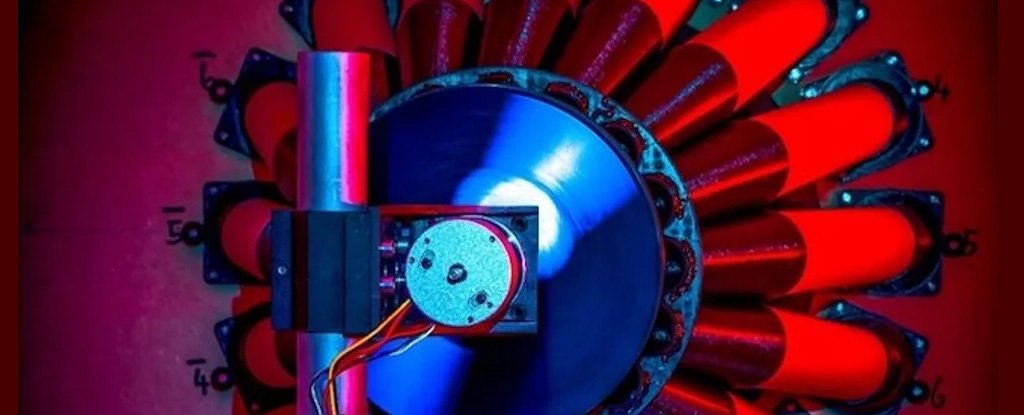
A 50-year theoretical process to extract energy from a spinning black hole finally has experimental verification.
Using an analogue of the required components, physicists have shown that the Penrose process is indeed a plausible mechanism for extracting some of that rotational energy, if we could ever develop the means.
That is not likely, but the work shows that peculiar theoretical ideas can be brilliantly used to explore the physical properties of some of the most extreme objects in the Universe.
Black holes are wild: the final stage in the life cycle of a star so massive that, once it has become a supernova, the nucleus can no longer support its own gravity and totally collapses into a singularity: a single one-dimensional point of infinite density.
This singularity lies within a region called the event horizon: the point at which gravity around the black hole is so strong that not even the speed of light is sufficient to achieve escape velocity. And outside the event horizon, an extended region of space-time twists as it crawls along with the rotation of the black hole, an effect called frame drag.
This is where the Penrose process comes in. In 1969, mathematical physicist Roger Penrose proposed that a region just outside the event horizon called the ergosphere, where frame drag is strongest, could be exploited to extract energy.
According to Penrose’s calculations, if an object dropped into the ergosphere were to split in two, one part would be thrown beyond the event horizon.
The other, however, would accelerate outward, with an additional kick from the black hole. If all went well, it would emerge from the ergosphere with about 21 percent more energy than it entered.
Now, we can’t just go to a black hole to test this. But in 1971, the Soviet physicist Yakov Zel’dovich proposed a more practical experiment. You could replace the black hole with a rotating metal cylinder and shoot twisted beams of light at it. If the cylinder were to rotate at the correct speed, the light would reflect back with additional energy drawn from the cylinder’s rotation, due to a quirk in something called the rotational Doppler effect.
If you are a regular reader, you may already be familiar with such an effect: it can be seen when a rotating source emits waves, which shorten and lengthen depending on the direction of rotation. The ripples on the side turning toward you will seem to shorten; The waves on the far spinning side seem to lengthen. This is how astronomers can measure the rotations of stars and galaxies.
There was only one problem with Zel’dovich’s proposal. The rotating cylinder speed should be at least one billion rotations per second; remember there is still a lot of space for impassability in “more practical than a black hole”.
So there the matter remained, until a team of physicists from the Faculty of Physics and Astronomy at the University of Glasgow in Scotland appeared. They devised an experiment based on Zel’dovich’s work, but instead of using light waves, they used sound waves.
 The experiment. (Cromb et al., Nature Physics, 2020)
The experiment. (Cromb et al., Nature Physics, 2020)
The experiment consisted of a speaker ring configured to introduce a twist into the sound waves, analogous to twisted light in the Zel’dovich experiment. The ‘black hole’ was a spinning sound absorber made of a foam disc, the rotation of which would accelerate as sound waves hit it. A series of microphones on the other side of the disc would detect sound waves after they have passed through the disc.
The smoking gun that would verify the Penrose process was a change in the pitch and amplitude of the sound waves that passed through the disc.
“Twisted sound waves change their pitch when measured from the point of view of the rotating surface,” explained physicist and astronomer Marion Cromb of the University of Glasgow, lead author of the team’s article.
“If the surface rotates fast enough, the frequency of sound can do something very strange: It can go from a positive frequency to a negative frequency, and in doing so, steal some energy from the rotation of the surface.”
The results were astonishing. As the disc’s rotation accelerated, the pitch of the sound that hit the microphones dropped until it was inaudible. Then it began to rise again to the original pitch, but 30 percent higher than the sound coming from the speakers. The sound waves collected additional energy from the spinning disk.
 (University of Glasgow)
(University of Glasgow)
“What we heard during our experiment was extraordinary,” said Cromb.
“What is happening is that the frequency of the sound waves is changed to Doppler at zero as the spin speed increases. When the sound starts again, it is because the waves have been changed from a positive frequency to a frequency Negative. Those negatives – the frequency waves are able to take some of the energy out of the spinning foam disk, getting stronger in the process, as Zel’dovich proposed in 1971. “
The team plans to try to figure out how to extend this research to electromagnetic waves, light, but this research is a big step forward in understanding black holes. It shows how its extreme properties can be tested in laboratory settings if you have the right tools, and sophisticated, high-tech Bose-Einstein condensates don’t always have to be condensed.
Research like this could also lead to new technologies, if a way can be devised to take advantage of this fascinating phenomenon.
“We are delighted that we were able to experimentally verify extremely strange physics half a century after the theory was first proposed,” said physicist Daniel Faccio of the University of Glasgow.
“It is strange to think that we have been able to confirm a half-century theory with cosmic origins here in our laboratory in western Scotland, but we believe that it will open up many new avenues of scientific exploration.”
The research has been published in Physics of nature.
.